Hit-and-run accident – sounds self-explanatory, doesn’t it? Well, legal definitions often carry a different meaning than the one we’re used to. They cover various scenarios and situations we don’t usually think of.
Not to mention that the definition varies from state to state because of the different state laws.
So, if you sustained an injury due to the hit-and-run accident (or you’re curious to learn more about them), keep reading.

Contents
What are Hit-and-Run Accidents?
Just like the phrase says, a hit-and-run accident has two components.
The first one is the hit,whichrefers to the collision of a vehicle with a pedestrian, a car, a fixed object, or (in some states) an animal.
The second component is the run, which happens when the perpetrator leaves the crime scene without identifying themselves or helping the person they’ve injured.
Remember that, in most states, the hit doesn’t have to take place on a highway or a public road. For instance, hitting an empty car in a parking lot without leaving a note with contact information is also considered a hit-and-run.
A hit-and-run doesn’t need to result in an injury or death for the driver to be responsible, but the consequences are more severe if that’s the case.
Penalties for Hit-and-Run Accidents
There are two types of punishments for drivers involved in hit-and-runs: criminal penalties and civil penalties.
We will go over the criminal penalties first, as they’re something people usually associate penalties for hit-and-runs with.
Criminal Penalties
Depending on the circumstances, a hit-and-run can be classified as a felony or a misdemeanor. The penalties for felonies are usually more severe, but misdemeanor penalties are also no joke.
Here’s an example of a felony: imagine someone driving a truck and hitting a pedestrian on a crosswalk. The driver gets scared, starts panicking, and runs off. If the pedestrian gets seriously injured or dies, the driver may serve up to 7 years in jail.
If the pedestrian gets off with a scratch, it would be considered a misdemeanor. In that case, the perpetrator may be forced to pay up to $5,000, spend one year in jail, or both. Either way, a driving license is also revoked for one year.
As you can see, a felony has more severe consequences than a misdemeanor.
Civil Penalties
Aside from the criminal penalty, the person involved in the crash can sue the perpetrator for the damages they suffered. This can include medical bills they had to pay, lost wages, or property damage. These are called compensatory damages because they cover the actual damage you have due to the hit-and-run.
Aside from compensatory damages, two more types of damages may be awarded in court: punitive and treble damages.
Punitive damages serve to punish the perpetrator whose behavior was particularly dangerous. They’re not meant to cover the injured person’s losses but to deter them from repeating their mistake in the future.
If the driver commits the act deliberately, the court can also award a plaintiff up to three times their compensatory damages. This type of damages is called treble damages. For instance, if the jury awards the plaintiff $15,000 in compensatory damages, a statute related to civil penalties might allow the judge to triple that amount to $45,000.
Is there Something else I need to know?
Yes, there is.
Before you file the lawsuit, you should know that there’s a statute of limitations to bring hit-and-run charges. It varies from state to state. In New York, it’s three years from the date of the accident.
Now, if you’re not keen on filing a lawsuit, we have some good news – most of the time, you’ll be able to work out a settlement outside of court. But, before you accept the settlement offer, make sure to contact an experienced lawyer like S&B lawyers in NYC for the hit-and-run accident. They can negotiate the terms in your favor and minimize potential losses.

